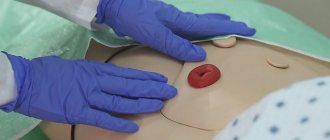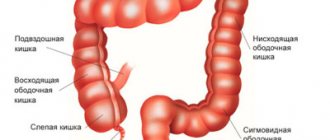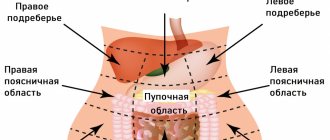Closing the colostomy postoperative period. Closing the colostomy
If the stoma is temporary, surgery will be needed to close it.
It is performed only when the patient’s health has been restored, he has recovered from the consequences of the formation of a colostomy. It is usually performed 12 weeks after the initial intervention. However, the recovery process may take longer if further treatment, such as chemotherapy, is required. There is no exact limit in this case; some people can live with a colostomy for several years before it is closed.
Sometimes surgery to close a colostomy is not recommended. For example, if the muscles that control the anus (sphincter muscles) have been damaged. Then the elimination of the stoma will cause intestinal incontinence.
The operation to close a loop colostomy is relatively simple. The surgeon makes an incision around the stoma. The upper part of the large intestine is connected to the rest of the colon.
Surgery to close an end colostomy is a more invasive surgery because the doctor will need more access to the abdomen. Therefore, the risk of complications will be higher and the recovery period will be longer.
Most patients feel well enough to leave the clinic 3-10 days after such surgery. It will take some time for normal bowel function to be restored. Some people experience diarrhea, but it goes away over time. There is pain in the anal area. The use of protective creams such as Sudocrem is suggested.
The operation to close a colostomy is less extensive than to create one. However, it will take several weeks to recover and return to normal life.
How to care for an intestinal stoma at home
10-14 days after the operation the patient is discharged home. During hospital treatment, the nurse teaches the patient how to care for the stoma and how to properly install and remove a colostomy bag. At home, it is important to carefully monitor the condition of the skin and general well-being.
The size of the stoma will gradually decrease over the first 6-8 weeks after surgery. At this time, you need to learn how to independently select the size of the adhesive plate each time you change the colostomy bag. It must exactly match the size and shape of the stoma. If the hole is cut correctly, there will be no gap between the artificial anus and the adhesive pad.
Sticking and emptying colostomy bags
It is recommended to change fecal bags in the morning and evening before eating so as not to irritate the skin. You can change devices more often if itching, burning or other unpleasant symptoms occur. The whole process takes place in several stages:
- Prepare everything you need to change your colostomy bag - a new bag, scissors, an ostomy meter, soft wipes, skin care products.
- Carefully peel off the plate, moving from top to bottom.
- Wash the skin around your stoma thoroughly with warm water. Dry with a napkin. Important: you must wash your skin without using shower gels or soap.
- Using a special template, select the required hole size for the ink collector.
- Place the template on the paper protective covering of the ink container and trace it with a pen.
- Cut a hole in the adhesive layer along the contour.
- Warm the colostomy bag to body temperature by placing it under the armpit.
- Remove the protective paper covering.
- Place the lower edge of the hole along the lower border of the stoma.
- Slowly glue the colostomy bag to avoid wrinkles.
- Press the device against your skin with your palm for 1-2 minutes.
- If you are performing the procedure for the first time, look at the step-by-step photos.
Skin care
To prevent injury and inflammation, the skin requires constant care. After removing the colostomy bag, it is recommended to clean the skin with warm water. It is allowed to use hydrogen peroxide or Klinzer paste. It gently removes glue residues, does not irritate and does not cause allergies. To securely fix the colostomy bag, use:
- Coloplast paste. The drug evens out folds and unevenness of the skin, ensures tight adhesion of the adhesive base to the epidermis.
- Protective film Second skin. It prevents the development of dermatitis, protects the skin from the aggressive effects of urine and feces.
What can you eat after surgery to close your stoma? FAQ (Frequently Asked Questions)
The operation to close the stoma is performed with a temporary artificial anus several months after the opening is formed. In some cases, intestinal reconstruction is not possible (tumors, removal of a large part of the organ, risk of bleeding). The nuances of the intervention depend on the underlying disease, the patient’s condition, and the results of laboratory and instrumental examinations.
When is an artificial anus closed?
Having an ostomy in the colon area is certainly a serious stress for the patient. Despite the perfection of technology, such a device entails the need for continuous and careful care, the cost of disposable materials, and the need to monitor the condition of the digestive tract, including through a strict diet. Therefore, if it is possible to restore natural bowel movements, the colostomy is closed.
Reconstructive surgery is performed in a colorectal surgery department, usually 2-6 months after the initial intervention.
In general, experts believe that stoma removal is best done during the first year after the formation of an artificial opening for defecation, between 3 and 12 months. But everything is individual, and the waiting interval may be shortened.
What should be the preliminary preparation?
Closing the artificial opening on the abdominal wall is carried out after consulting the attending physician. If the patient has undergone surgery for a tumor, it is necessary to clarify whether there is a relapse or metastasis. The standard diagnostic examination package includes:
- General blood test, biochemical.
- Urine examination.
- Blood type, Rh factor.
- Test for syphilis, HIV, hepatitis B, C.
- Coagulogram.
- Electrocardiography (ECG).
- Ultrasound of the abdominal organs.
- Endoscopy of the upper gastrointestinal tract and intestines.
Additionally, ultrasound of the kidneys, pelvis, CT (computed tomography), irrigoscopy, consultation with an infectious disease specialist, therapist, or cardiologist may be prescribed. The patient follows a diet and, in the absence of contraindications, is hospitalized in the hospital department where intestinal reconstruction will be performed.
How is a stoma closed?
The patient is examined by the attending surgeon (the results of the examination performed the day before are necessarily evaluated), and the anesthesiologist responsible for the anesthesia technique conducts a conversation. Immediately before the operation, blood, urine and coagulogram tests are repeated. Eating is prohibited, you need to cleanse the intestines (this is done by washing the stoma and taking a laxative - for example, the drug "Fortrans").
The course of the colostomy closure operation includes the following stages:
- pain relief (epidural anesthesia or endotracheal anesthesia);
- abdominal wall incision;
- cleansing the edges of the intestine;
- stitching damaged areas;
- intestinal reconstruction;
- installation of drains;
- suturing.
When anesthesia is administered, the patient wakes up in the ward. A bladder catheter is used before and after the intervention. The duration of the operation is on average from 2 to 5 hours.
What complications can there be?
During the normal course of the rehabilitation period, after the stoma is closed, the damaged tissues are restored, and the intestines work fully again (of course, this does not mean giving up the diet and the absence of the risk of repeated exacerbations; the operation does not cure the underlying disease). Possible complications include:
- Intra-abdominal abscess.
- Infection of a postoperative wound.
- Pneumonia.
- Bleeding.
- Fecal fistula.
- Failure of the anastomosis (connection in the area of the gastrointestinal tract that was previously brought out).
- Intestinal obstruction.
All described consequences can be eliminated in a surgical department. High-quality preparation for surgery is also a preventive measure. It is worth noting that there are complications associated with non-compliance with the regime after the intervention (for example, an inflammatory process due to a violation of the diet).
I am going for surgery to close my stoma. When is surgery to close a colostomy possible?
What is a colostomy? The term colostomy refers to a surgically created connection between the colon and the anterior abdominal wall to remove intestinal gases and stool. A colostomy is formed during surgical interventions for colon cancer, injuries, Crohn's disease, ulcerative colitis. The stoma can be permanently applied, in which case it remains with the patient for the rest of his life, or temporarily - with the aim of further restoring the integrity of the intestine.
When to close a colostomy?
Formation of a colostomy
Most often, surgery to close a colostomy is performed three to six months after the first surgery, but there are other options. Some surgeons prefer to perform reoperation within the first two months, arguing that this period is the least likely to cause complications. Studies have also been conducted that show that closing the stoma within the first two weeks is most effective. But this method is not suitable for all patients; it is used for isolated injuries of the rectum and in cases where the postoperative period passes without complications.
Technique of reconstructive surgery The essence of reconstructive surgery is to restore intestinal continuity by connecting the remaining parts of the intestine. The technique for closing the stoma depends on the technique of the first surgical intervention and occurs through local access or full laparotomy. In any case, this decision should only be made by the attending physician. The operation can be one- or two-stage. If the operation is performed in two stages, then repeated surgery can be performed laparoscopically, which significantly reduces trauma and therefore reduces the risk of complications.Additional complications can be created by adhesions, scars or the small size of the remaining section of the rectum.
Postoperative period Undoubtedly, after the operation you will have to get used to a new lifestyle: diet and adherence to a diet are necessary. The intestines are not yet able to process all products and bowel movements occur irregularly, and there may be problems with stool. Therefore, it is worth following certain rules.• Food must be taken at a certain time, and breakfast should be hearty and dinner should be light.• Before breakfast, you should drink a glass of boiled, chilled water - this will enhance peristalsis, and you will be able to control bowel movements.• Determine which foods They cause increased peristalsis in you (most often these are foods high in plant fiber, sugary substances, fermented milk products), and some slow them down (rice, jelly, crackers, cottage cheese, coffee, cocoa, strong tea).
And most importantly, if something bothers you, you should immediately contact your doctor. Be healthy!
Types of colostomy photo
There are many different types of colostomy, each corresponding to a different section of the colon.
Sigmoid: This is the most common type of colostomy, affecting the lower part of the colon, and is used for Crohn's disease.
Transverse Loop: A transverse colostomy affects the upper abdomen. This procedure evacuates a loop of intestine, creating two openings: the proximal end, which is where the pouch is attached, and the distal end, which is inactive (no stool comes out of this end).
Transverse single-barrel: This method creates a single hole through the abdominal wall. This is permanent and is sometimes called a terminal colostomy. Transverse double-barrel: In this method, the two ends of the intestine are sutured together and passed through the abdominal wall.
Descending: This method is performed on the left side of the colon. Having already passed through the right side of the colon, the stool is solid and controlled.
Ascending: This method is performed on the right side of the colon. The stool is usually liquid. This is a rare operation because a small bowel stoma is usually preferred.
The first days after the stoma is closed. Lifestyle after stoma removal
After surgery and removal of part of the intestine, a temporary or permanent intestinal stoma is formed, depending on the severity of the pathology, the general condition of the patient and concomitant diseases. A temporary stoma is formed in preparation for surgery, in case of adhesions or intestinal obstruction.
To prevent intestinal contents from entering the surgical field, a temporary colostomy is also formed. Usually, after the creation of unnatural temporary anuses, the intestines function normally. The key goal of stoma removal (reconstructive coloplasty) is to return the patient to their normal lifestyle.
The stoma is removed during the recovery stage of treatment of intestinal pathologies. As a rule, in case of inflammatory diseases of the abdominal cavity or complications during the formation of a stoma, removal is carried out 2-4 months after the first operation. After closing the stoma, it is necessary to restore the natural functions of the intestine and the normal structure of the body. During the operation, which is performed under general anesthesia for 1.5-2 hours, the surgeon makes an incision, removes a segment of the intestine, returns it to its natural position and connects it to other parts of the intestinal system, stitches the muscle tissue, and puts a suture on top.
After the operation, the tightness of the intestines is checked, and the patient regains his natural ability to defecate. Recovery after closure of the stoma To effectively restore intestinal function, doctors prescribe a special diet and nutrition regimen, medication and colon hydrotherapy (hydromassage and bowel cleansing). During the rehabilitation period, the consumption of raw fruits and vegetables, spicy and fried foods is excluded for six months.
Only liquid food is indicated. 4 months after the stoma is closed, you can include baked or boiled vegetables and fruits in your diet. The recovery period varies for each patient, depending on age, general condition of the body, and the presence/absence of concomitant pathologies.
The doctor will set the end date of rehabilitation after diagnosis. After complete restoration of the intestines, you can play sports with light physical activity, travel, indulge in intimate relationships and have a more varied diet. In this case, you should regularly visit your doctor for routine examinations.
What is a colostomy bag and why is it needed?
The reservoir for receiving stool in people with a colostomy is called a colostomy bag. Externally, it looks like a small bag made of odor-proof film with an adhesive flange to secure the reservoir to the skin. Colostomy bags vary in appearance, type of fixation, and size.
Types of colostomy bags
For the first time after surgery, large transparent colostomy bags are used. This choice of reservoir is necessary for doctors to visually assess the consistency and color of stool. After discharge, the colostomy bags are replaced with smaller ones. The optimal option is selected by the doctor at the rehabilitation stage. There are three types of devices:
- Single-component ones consist of a bag for collecting feces and adhesive tape. They need to be changed 2-3 times a day, depending on the frequency of bowel movements.
- Two-component ones are equipped with an ostomy bag and a self-adhesive plate, connected by special flanges. The convenience of such devices is that the sticky part is left for 3-4 days, and the bag is changed several times a day.
- Drainage - stool containers for cancer patients with loose stools or a tendency to diarrhea. Such bags must be emptied when they are 1/3 full. To do this, the patient bends over the toilet and opens the drainage hole.
Article on the topic: Kidney failure - symptoms
Bandage after stoma closure. How to wear a bandage? Is there a bandage for an ostomy?
Doctors recommend that almost all patients who have undergone abdominal surgery wear a bandage to avoid postoperative complications.
Nowadays there are a great variety of bandages. They can be bought both in pharmacies and purchased to order. All of them are made of elastic materials.
The hole for the colostomy bag DOES NOT CUT. The bandage must be put on ONLY LYING UP.
You lie down and fasten the bandage quite tightly. When you breathe, the abdominal muscles begin to move, the bandage begins to move apart a little, then stops. When you take a vertical position, your stomach protrudes forward a little, and the bandage begins to hold it, and in no case squeeze it.
For some patients, it is enough to wear a bandage for 6 months after surgery. We still recommend that most of our patients use the bandage for many years, explaining that they do not need to wear it all the time. You should only wear it when leaving home if you are going on a long walk or trip. While at home, it is not necessary to wear a bandage and you should not sleep in it either. If you are going to work in your garden plot, it is also better to do this in a bandage. Do not forget also that lifting heavy objects is contraindicated for you. If you have impairments in the functioning of the musculoskeletal system and you have to move with the help of a cane, you must wear a bandage. There is a misconception that a bandage placed on top of a colostomy bag prevents the release of feces into the colostomy bag - this is incorrect. A correctly worn bandage does not interfere with bowel function or the rules for using a colostomy bag. Very often, failure to follow the recommendations of the dentist results in the appearance of surgical complications - paracolostomy and ventral hernias, prolapse of the stoma mucosa. These complications are non-fatal, but extremely unpleasant. Most often this happens because patients do not use the bandage, or use it incorrectly, putting it on themselves too tightly.
If you still have questions, BE SURE TO ASK THEM TO YOUR DENTIST at your next appointment.
Prognosis after colostomy closure. Complications of colostomy
Forming a colostomy is a complex operation that requires high skill of the surgeon. However, proper care in the postoperative period is no less important. Colostomy is accompanied by the risk of complications that require referral to a specialist. Such situations include: abscess (inflammation of tissue near the colostomy), necrosis (death of tissue), retraction or prolapse of the intestine, eventration (separation of the wound with prolapse of the intestine). A qualified doctor knows how to treat inflammation of a colostomy. When the first signs of complications appear, you should immediately seek help.
It is necessary to know in what cases pain occurs around a colostomy. Medical personnel provide information about this to the patient in the postoperative period, teaching the patient how to independently care for the colostomy. Pain occurs when tissue nutrition is disrupted, the inflammatory process develops, or the wound heals poorly. Spasms after colostomy removal may also be accompanied by pain. If your colostomy is bleeding, you should see a doctor immediately. This condition can be dangerous and requires urgent elimination.
The narrowing of the excreted hole occurs as a result of scarring of the wound. In advanced cases, this leads to difficulty in defecation or obstruction. A change in the diameter of the outlet is considered a normal process if regular bowel movements occur and the patient does not experience discomfort. What to do if there is no bowel movement during a colostomy? It is necessary to urgently consult a doctor to clarify the situation and receive timely treatment.
Complications after closing a colostomy are mainly associated with leaks in the sutures connecting the intestinal walls. After stitching the intestine, the tightness of the connection is checked using contrast. This is important to avoid divergence of the sutures on the intestine.










